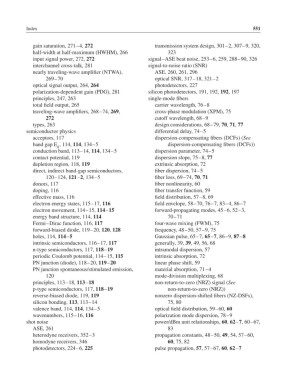Page 570 - Fiber Optic Communications Fund
P. 570
Index 551
gain saturation, 271–4, 272 transmission system design, 301–2, 307–9, 320,
half-width at half-maximum (HWHM), 266 323
input signal power, 272, 272 signal–ASE beat noise, 253–6, 259, 288–90, 326
interchannel cross-talk, 281 signal-to-noise ratio (SNR)
nearly traveling-wave amplifier (NTWA), ASE, 260, 261, 296
269–70 optical SNR, 317–18, 321–2
optical signal output, 264, 264 photodetectors, 227
polarization-dependent gain (PDG), 281 silicon photodetectors, 191, 192, 192, 197
principles, 247, 263 single-mode fibers
total field output, 265 carrier wavelength, 76–8
traveling-wave amplifiers, 268–74, 269, cross-phase modulation (XPM), 75
272 cutoff wavelength, 68–9
types, 263 design considerations, 68–79, 70, 71, 77
semiconductor physics differential delay, 74–5
acceptors, 117 dispersion-compensating fibers (DCFs) (See
band gap E , 114, 114, 134–5 dispersion-compensating fibers (DCFs))
g
conduction band, 113–14, 114, 134–5 dispersion parameter, 74–5
contact potential, 119 dispersion slope, 75–8, 77
depletion region, 118, 119 extrinsic absorption, 72
direct, indirect band-gap semiconductors, fiber dispersion, 74–5
120–124, 121–2, 134–5 fiber loss, 69–74, 70, 71
donors, 117 fiber nonlinearity, 60
doping, 116 fiber transfer function, 59
effective mass, 116 field distribution, 57–8, 69
electron energy states, 115–17, 116 field envelope, 58–70, 76–7, 83–4, 86–7
electron movement, 114–15, 114–15 forward-propagating modes, 45–6, 52–3,
energy band structure, 114, 114 70–71
Fermi–Dirac function, 116, 117 four-wave mixing (FWM), 75
forward-biased diode, 119–20, 120, 128 frequency, 48–50, 57–9, 75
holes, 114, 114–5 Gaussian pulse, 65–7, 65–7, 86–9, 87–8
intrinsic semiconductors, 116–17, 117 generally, 39, 39, 49, 56, 68
n-type semiconductors, 117, 118–19 intramodal dispersion, 57
periodic Coulomb potential, 114–15, 115 intrinsic absorption, 72
PN junction (diode), 118–20, 119–20 linear phase shift, 59
PN junction spontaneous/stimulated emission, material absorption, 71–4
120 mode-division multiplexing, 68
principles, 113–18, 113–18 non-return-to-zero (NRZ) signal (See
p-type semiconductors, 117, 118–19 non-return-to-zero (NRZ))
reverse-biased diode, 119, 119 nonzero dispersion-shifted fibers (NZ-DSFs),
silicon bonding, 113, 113–14 75, 80
valence band, 114, 114, 134–5 optical field distribution, 59–60, 60
wavenumbers, 115–16, 116 polarization mode dispersion, 78–9
shot noise power/dBm unit relationships, 60, 62–7, 60–67,
ASE, 261 83
heterodyne receivers, 352–3 propagation constants, 48–50, 49, 54, 57–60,
homodyne receivers, 346 60, 75, 82
photodetectors, 224–6, 225 pulse propagation, 57, 57–67, 60, 62–7

